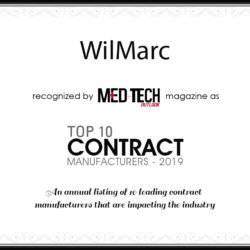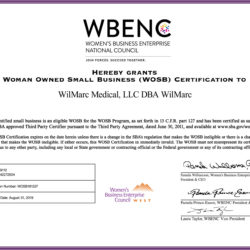WilMarc is dedicated to producing medical devices that are PVC-Free, BPA Free, and Phthalate-Free. Although the use of polyvinyl chloride (PVC) is common in the medical industry, global concern about the health and environmental risks associated with PVC is growing. Sweden began placing strict restrictions on its use in 1995 and is moving toward eliminating its use entirely. Over 60 cities in Spain have been declared PVC-free. New York City, Boston, Seattle, San Francisco, and Buffalo, NY, are phasing out the purchase of PVC and products like it, and countries worldwide are strengthening restrictions on its production and disposal.
The potential risks of the production and disposal of polyvinyl chloride are substantial. In fact, The Center for Health, Environment and Justice called it “one of the most hazardous consumer products ever created”. Because of the difficulty of shifting the manufacturing and medical industries away from PVC however, it remains prevalent in the medical field. It can be found in use in a variety of hospital settings including:
- Nasal cannulas
- IV and blood bags
- Infusion administration sets
- Enteral feeding devices
- Tubing
- Catheters
- Breathing circuits
Unfortunately, the very polyvinyl chloride products produced to ensure the health of patients may end up having the opposite impact. Plasticizers used to soften PVC such as DEHP phthalates have been banned in toys in the US since 2008, but these dangerous additives still show up in other PVC products. Although more research is required to know the full extent of the effect of exposure to PVC on humans, the toxic effects are apparent.
DEHP Free
Because PVC can be a rigid plastic material, manufacturers must use plasticizers to make it malleable and flexible. Phthalates, the most common of these plasticizers, have been linked by studies to many health concerns.
DEHP or Di(2-Ethylhexyl) Phthalates are not chemically bound to PVC and are thus able to leach, migrate, or evaporate from devices treated with them. This means patients treated with PVC medical equipment and even the healthcare professionals handling them can potentially be exposed to DEHP leachate. In the worst case scenarios, the leachates could literally be transported via the equipment into the patient.
While there is no current consensus on the level of risk phthalates like DEHP pose to the health of those exposed, numerous studies published report a wide range of toxic effects including:
- Male neonate reproductive system developmental issues
- Functional liver damage
- Cancer
WilMarc is dedicated to producing medical devices that are PVC-Free, BPA Free, and Phthalate-Free.
Health Risks of PVC Production
In addition to the risks of DEHP, the production of medical PVC tubing emits a number of carcinogens including ethylene dichloride, vinyl chloride, vinyl acetate, vinylidene chloride, and dioxin.
These carcinogens have been linked in numerous published studies to a plethora of severe health issues including:
- Neurological Damage
- Birth Defects
- Impaired Child Development
- Reproductive and Immune System Damage
- Endocrine Disruption
- Cancer
People working with PVC run the highest risk of exposure, but even communities near the manufacture may be exposed.
Environmental Damage of PVC
In addition to the risks related to its production, the disposal of PVC is probably the most problematic of its life cycle. Until recently, incineration was a common method of disposal. When burned, the chlorinated plastic produces dioxin, that if placed in a landfill, release toxic additives like phthalates and may potentially leach into surrounding water and soil. Even recycling PVC proves difficult. Not only does it interfere with the recycling of other plastics, harmful additives are still present in the recycled material.
This is why WilMarc is dedicated to manufacturing clean and green components. Our high quality medical devices are environmentally safe when disposed and naturally are PVC-Free and Phthalate-Free. WilMarc was formed to change the thinking of the disposable medical device industry while meeting the needs of the clinicians that keep us all well.




